 | |
|
NAVIGATION Home Hawaii Info Geography Flora & Fauna People Culture Economy Political ...about Kauai Hawaii Maps Kauai Oahu Maui & Lanai Big Island Hawaii Weather Hawaii Calendar Scenic Tours Music Links CLICK TO SHOP Hawaiian Music Search for: Artist/Title |
Kauai History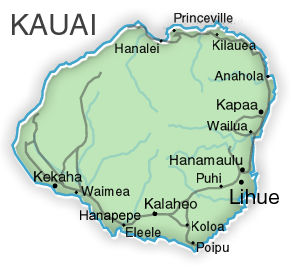 Kauai is situated NW of Oahu (separated from Oahu to the southeast by the Kauai Channel).
This northernmost and geologically the oldest of the major Hawaiian Islands is also the
most verdant and is known as the Garden Isle. Kauai county embraces nearby Niihau Island
(73 square miles) and the tiny uninhabited islets of Kaula and Lehua.
Kauai is situated NW of Oahu (separated from Oahu to the southeast by the Kauai Channel).
This northernmost and geologically the oldest of the major Hawaiian Islands is also the
most verdant and is known as the Garden Isle. Kauai county embraces nearby Niihau Island
(73 square miles) and the tiny uninhabited islets of Kaula and Lehua.
Fire-born Hawaiian Islands - Molten lava spewed out for about two million years forming an enormous underwater mountain and finally rising 3 miles from the ocean floor. For seven and a half million years, these volcanic eruptions continued - until the island of Kauai, circular in shape and roughly 550 square miles, was born. The highest mountain, Kawaikini Peak, rises to 5,243 ft. (1,598 m) above sea level, closely followed by Mt. Waialeale 5,080 ft. (1,548 m) as the second tallest peak. The northeastern slopes of Waialeale, one of the wettest spots on earth, receive an annual average rainfall of 450 in. (1,143 cm). This high annual rainfall has eroded deep valleys in Kauai's central mountain mass and formed spectacular canyons. Waimea Canyon, the "Grand Canyon of the Pacific" is almost 10 miles (about 16 km) long and more than 0.5 miles (0.8 km) deep.  The seeds of most plant species were carried to Kauai by birds, winds, or currents and tides,
bringing about extensive forestation, shrubbery, and grasslands, where soil and precipitation
were favorable. Since the first Polynesian settlement a tremendous variety of food and
ornamental plant life from many parts of the world has been introduced.
The seeds of most plant species were carried to Kauai by birds, winds, or currents and tides,
bringing about extensive forestation, shrubbery, and grasslands, where soil and precipitation
were favorable. Since the first Polynesian settlement a tremendous variety of food and
ornamental plant life from many parts of the world has been introduced.
Food plants grown commercially or in backyards for home consumption include sugarcane, pineapples, papayas, bananas, mangoes, guavas, lichee, coconuts, avocados, breadfruit, macadamia nuts, limes, passion fruit, taros, and tamarinds. Nearly all varieties of common garden vegetables are raised in the islands, and flowers abound all year. Endemic birds, long isolated from others of their kind, have taken on certain characteristics of their own. These include the nene (Hawaiian goose), the Hawaiian stilt, and a variety of small forest birds. Some species have become extremely rare, but as the result of an increased environmental awareness, great strides have been taken to preclude their extinction. Seabirds nest in profusion on the western islands of the archipelago and to a far lesser extent among the major eastern islands. 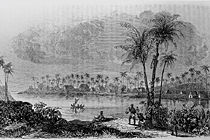 There has been considerable importation of birdlife. Quantities of mynas, sparrows, cardinals,
and doves live in the trees in both urban and country areas. Every fall the small golden plover
make an awe-inspiring, nonstop 3,000 mile (4,800 km) flight from Alaska to Hawaii, where
they spend the winter, together with ducks from Alaska, Canada, and the northwestern United States.
There has been considerable importation of birdlife. Quantities of mynas, sparrows, cardinals,
and doves live in the trees in both urban and country areas. Every fall the small golden plover
make an awe-inspiring, nonstop 3,000 mile (4,800 km) flight from Alaska to Hawaii, where
they spend the winter, together with ducks from Alaska, Canada, and the northwestern United States.
Wild animal life includes mongooses, rats, frogs, toads, and, in the more remote regions of the island, sheep, pigs, and goats. The insect population is multitudinous, and marine life abounds in Kauai waters. Kauai is regarded as the most tropical island and has been given the name "The Garden Island".  There are no known written records of the first settlers to Kauai, although its is
believed that the first inhabitants of Hawaii may have reached the islands as
early as 400 AD from the Marquesa Islands. Contact with and settlement by Tahitians began about 1000 AD.
There are no known written records of the first settlers to Kauai, although its is
believed that the first inhabitants of Hawaii may have reached the islands as
early as 400 AD from the Marquesa Islands. Contact with and settlement by Tahitians began about 1000 AD.
Why they sailed into unfamiliar seas is not known, but among the possible reasons might be war or religious freedom. E.S. Craighill Handy, an authority on life in the Marquesas during ancient times, wrote that "the density of the population in the Marquesas was equal to the maximum that could be supported by agricultural and fishing industries of the primitive order practiced by the natives". Traveling nearly 2,600 miles from their homeland and fighting the cruel seas of the Pacific, these Polynesian sailors had none of the navigational equipment common today, yet they made long voyages over open seas - well before spanish and portuguese sailors were willing to sail beyond the sight of land. They sailed by the stars, by the currents, and by the winds. Their ability as sailors was phenomenal.  Powerful classes of chiefs and priests arrived and established themselves, followed by
conflicts, similar to the feudal struggles in Europe, with complicated land rights contributing to
the disputes. The early Hawaiians lacked a written language, and their culture was entirely
oral and rich in myth, legend, and practical knowledge, especially of animals and plant life.
Powerful classes of chiefs and priests arrived and established themselves, followed by
conflicts, similar to the feudal struggles in Europe, with complicated land rights contributing to
the disputes. The early Hawaiians lacked a written language, and their culture was entirely
oral and rich in myth, legend, and practical knowledge, especially of animals and plant life.
The material life of the island was hampered by the lack of metal, pottery, or beasts of burden, but there was great skill in the use of wood, shell, stone, and bone, and the huge double and outrigger canoes were technical marvels. Navigational methods were well developed, and there was an elaborate calendar. Athletic contests encouraged warrior skills. Each island developed its own hierarchical government system and appointed it's own ruler. The Kauai chiefs, the sacred Hawaiian aristocracy (Ali'i), ruled the island from the Wailua River valley on the Coconut/Eastcoast of Kauai with a strict religious system called Kapu. This valley was forbidden and off limits for all commoners. 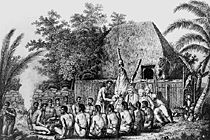 Captain James Cook, the English explorer and navigator, is generally credited with having
made the first European discovery of Hawaii; he first landed at Waimea, Kauai, on Jan.
20, 1778. Upon his return in the following year, he was killed during an affray with a number
of Hawaiians at Kealakekua Bay on February 14, 1779.
Captain James Cook, the English explorer and navigator, is generally credited with having
made the first European discovery of Hawaii; he first landed at Waimea, Kauai, on Jan.
20, 1778. Upon his return in the following year, he was killed during an affray with a number
of Hawaiians at Kealakekua Bay on February 14, 1779.
The initial discovery by Cook was followed by a period of intermittent contact with the West. During this period Kamehameha I used European military technology and weapons to emerge as an outstanding Hawaiian leader, seizing and consolidating control over most of the island group - except Kauai. In April 1796, after conquering Maui and Oahu, he launched his first attack against the sovereign Kauai - only to fail due to bad weather. In 1804 he attempted a second time with 900 canoes and an army of 10,000 warriors and again - it wasn't to be. An epidemic of cholera infected and decimated his army. But Kamehameha, undaunted by his repeated failure, was still in pursuit of Kauai. Warnings of his wrath caused the King of Kauai (Kaumualii) to sign a treaty with Kamehameha, under which Kaumalii would remain as ruler of Kauai - while pledging allegiance to Kamehameha. This allowed Kamehameha in 1810 to unite all the Hawaiian Islands in one kingdom - without ever conquering the island of Kauai. 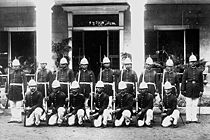 For 85 years thereafter, monarchs ruled over the Hawaiian kingdom. In the early 19th century
the American whaling fleet began wintering in Hawaii, and the islands were visited with
mounting frequency by explorers, traders, and adventurers. Captain George Vancouver
introduced livestock to the islands in 1792. In 1820 the first of 15 companies of New England missionaries arrived.
For 85 years thereafter, monarchs ruled over the Hawaiian kingdom. In the early 19th century
the American whaling fleet began wintering in Hawaii, and the islands were visited with
mounting frequency by explorers, traders, and adventurers. Captain George Vancouver
introduced livestock to the islands in 1792. In 1820 the first of 15 companies of New England missionaries arrived.
By the middle of the century there were frame houses, horse-drawn vehicles, schools, churches, taverns, and mercantile establishments. A written language had been introduced, and European and American skills and religious beliefs (Protestant and Roman Catholic) had been imported. Hawaiian culture was irrevocably changed. 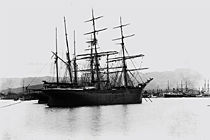 Political maneuvering between U.S., British, and French consuls and naval forces brought
about uncertainty in the governmental situation. The foundations of constitutional
government were nevertheless laid down with the promulgation, by Kamehameha III, of the
Declaration of Rights (June 7, 1839), the Edict of Toleration (June 17, 1839), and a written
constitution (Oct. 8, 1840).
Political maneuvering between U.S., British, and French consuls and naval forces brought
about uncertainty in the governmental situation. The foundations of constitutional
government were nevertheless laid down with the promulgation, by Kamehameha III, of the
Declaration of Rights (June 7, 1839), the Edict of Toleration (June 17, 1839), and a written
constitution (Oct. 8, 1840).
These progressive steps (made under missionary influence) were followed by formal avowals of Hawaiian independence by the United States, Great Britain, and France. The ambitions of these powers continued unabated, however, with a succession of overt and covert diplomatic moves, culminating in the signing of a reciprocity treaty with the United States in 1875. The kingdom was overthrown in 1893, and a republic was formed with U.S. support. This was followed by the joint annexation resolution of Congress in 1898, the final stamp of U.S. domination. This status was confirmed by the establishment of a territory on June 14, 1900. 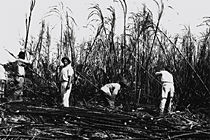 The period until 1940 was distinguished by a rapid growth in population, the development of
a modern economy based on the production of sugar and pineapples for consumption on the
U.S. mainland, and the growth of transport and military links. Movements for statehood,
based in part on Hawaii's obligation to pay U.S. taxes without having corresponding
legislative representation, began to emerge.
The period until 1940 was distinguished by a rapid growth in population, the development of
a modern economy based on the production of sugar and pineapples for consumption on the
U.S. mainland, and the growth of transport and military links. Movements for statehood,
based in part on Hawaii's obligation to pay U.S. taxes without having corresponding
legislative representation, began to emerge.
The Japanese attack on Pearl Harbor, on Dec. 7, 1941, precipitated not only Hawaii but the United States as a whole into World War II, and the islands were beset by an upsurge of military activity and a sometimes controversial curtailment of civil liberties. The post-1945 period was marked by further economic consolidation and a long constitutional path to statehood, a status finally achieved in 1959. Since statehood - tourism has grown on Kauai, with ever-increasing numbers of visitors, especially from Japan and the U.S. mainland. They are lured not only by the warm climate and exotic beauty of the islands but also by the unsurpassed friendliness of its people. Today - Kauai offers the visitor the tranquil unspoiled beauty of an island paradise with true Aloha spirit. |
|
[Home] - [Search for Artist/Title] - [Complete Listing] - [Hawaii Info] - [Links] - [Contact Information] Call Toll-Free 1-800-252-7731 -or- email hawaiianmusicstore@gmail.com | |